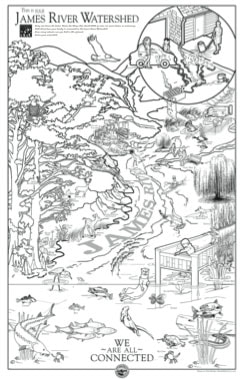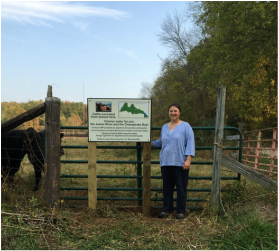Past Activities

James River Watershed Education Activity Sheets
The Roundtable was awarded a Chesapeake Bay Restoration Fund Grant supporting the creation of educational activity sheets for children. The activity sheets educate children and adults about watersheds and pollution prevention; the activity sheets are suitable for diners, family-style restaurants, community centers, churches and schools. One of the main goals of this project is to reach a diverse audience throughout the watershed. There are over 62,000 sheets ready to be distributed across the James River watershed. Contact us to receive activity sheets for your establishment » The activity sheet is designed to be an interactive way to educate and entertain children. The front of the sheet can be colored and allows for children to pinpoint everyday human activities and animals that impact the James River. The back portion of the sheet contains activities that connect children to the watershed including an educational and engaging pollution word search.
Storm Drain Markers Storm drains are not trashcans. Water flows untreated from our storm drains into our rivers. Therefore any waste dumped into a storm drain will be carried directly into the water that we rely on for drinking and recreating. If we remember, "only rain down the drain" and we keep our trash, waste, motor oil, pet waste and chemicals out of our storm drains, we can do our part to improve local water quality. The Middle James Roundtable had curb markers designed to label storm drains in the Middle James Watershed. These markers can be adhered to the sidewalk, curb or grate and are an easily visible reminder that our storm drains flow directly into the river untreated. Free curb marker kits are available! Contact us for an application. » Coaster Project The Middle James Roundtable’s Education and Outreach Working Group had coasters designed that are being distributed to local restaurants throughout the watershed. These coasters include five ways to help the James River. James River Association's Extreme Stream Makeover On October 19, 2009, the James River Association, with the help of local government, businesses and organizations, kicked off Extreme Stream Makeover 2009! The third project took place in the Blackwater Creek watershed. This watershed includes portions of Bedford & Campbell Counties, as well as the City of Lynchburg Activities began with the opening ceremonies on Monday, October 19. Hundreds of volunteers worked at various sites throughout the watershed, including Jefferson Forest High School, Peaks View Park, Blackwater Creek Athletic Area and several shopping centers along Wards Road. Extreme Stream Makeover is a week-long, local project aimed at sparking greater community involvement and public action to improve and restore water quality through a series of low impact design projects. In this case, low impact design refers to reducing the amount of rainwater runoff from roads, buildings, parking lots, and managed turf that enter stream and creeks and ultimately, the James River. For more information, visit JRA's Extreme Stream Makeover » Willis River Water Quality Implementation Project The Willis River in Cumberland and Buckingham Counties is currently listed as impaired for bacteria from the headwaters to its mouth at the James River. The impairment indicates that the stream presents an elevated risk of illness for individuals swimming or taking part in any activity that presents a possibility of ingestion of water. In 2005 local citizens and locality and agency representatives collaborated with Virginia DCR to develop the Willis River Water Quality Implementation Plan (Fecal Coliform TMDL). The plan outlined corrective actions needed to reduce bacteria entering the stream including excluding livestock from streams, replacement of failing septic systems and straight pipes (direct discharges household waste to streams), and educational activities. In September 2005, the Peter Francisco Soil & Water Conservation District began a project to implement the plan. Through an EPA grant, the District hired a Conservation Specialist to promote and design best management practices (BMPs) in the Willis River watershed. Funding was also provided for the installation of BMPs to exclude livestock from streams and improve waste treatment systems. By September 2008 there were 21 miles of stream exclusion fencing installed, removing 2,700 livestock from having direct stream access. One loafing lot management system, 10 septic system repair and one septic system replacement were completed. The Virginia Department of Environmental Quality's ambient monitoring program has shown improvements in violation rates of the river's bacteria standards. Yearly violation rates dropped following the TMDL development in 2002. No violations of bacteria water quality standard were recorded in 2002, 2004, or 2005. The rate rebounded slightly in 2006. Contact Peter Francisco, Soil and Water Conservation District at 434-983-4757 for more information. Rivanna River Watershed: Streamwatch Land Use Study
In Fall 2011, StreamWatch released its latest study, which examined the relationships between land use, stream habitat, and stream biology in the Rivanna River watershed. Stream health is closely related to land use. Rural landscapes with lots of forest have healthy streams. In addition, forested buffers alongside streams can protect and improve stream health. Unstable banks and excess sediment affect the health of many Rivanna streams. Urban areas with lots of paved surfaces have unhealthy streams. The relationship between land use and stream health is so strong that we can estimate stream health based on the amount of forest and development in the surrounding area. About 70% of streams in the Rivanna watershed are failing Virginia biological standard. This standard tells us whether streams support a variety of life forms. Streams with more life have better water quality, and can provide better services to humans. Such services include water supply, recreation, and aesthetic enjoyment. Most of the Rivanna watershed is semi-rural (exurban). In this exurban landscape, forest cover averages about 70%, and there are about 17 acres for every house. This amount of disturbance may seem mild, yet more than half of exurban streams failed the biological standard. Rural and exurban streams decline rapidly with increased development or deforestation. In urban areas, stream health is already poor. Therefore, urban streams do not respond dramatically to additional development. Fortunately, only 5% to 10% of streams are severely degraded. Most streams sit near the pass/fail cusp and might meet the standard with better care. However, based on current development practices projected land use changes, a third of the remaining healthy streams could fail the standard within 20 years. For more information and the Rivanna River watershed, visit StreamWatch.org » |
|




